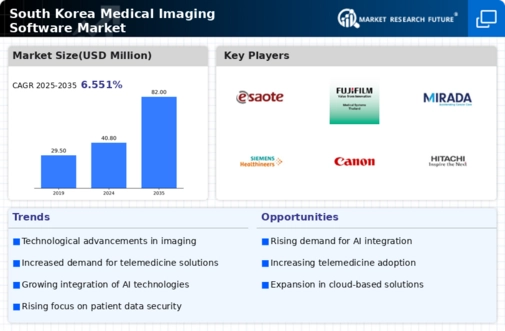The South Korea Medical Imaging Software Market is characterized by rapid growth and increasing competition, driven by advancements in healthcare technology and rising demand for diagnostic imaging solutions. The market landscape is supported by a blend of established players and emerging startups, all aiming to offer innovative software solutions that enhance imaging capabilities and improve patient outcomes. As the healthcare industry increasingly adopts digital transformation, the focus remains on providing high-quality imaging solutions that comply with regulatory standards and meet the growing needs of healthcare providers.
The competitive nature of the market is further intensified by the ongoing research and development efforts to introduce new products and improve existing technologies, positioning companies favorably in the eyes of healthcare professionals and institutions.Esaote has established a strong foothold in the South Korea Medical Imaging Software Market, primarily recognized for its cutting-edge ultrasound and MRI systems that cater specifically to diagnostic imaging needs. The company has carved a niche with a robust portfolio of software solutions designed for use in a variety of clinical settings, ensuring that healthcare providers can deliver precise diagnoses efficiently.
Esaote's strength lies in its commitment to enhancing patient care through innovative software features that integrate seamlessly with medical devices. Additionally, strong partnerships with local healthcare organizations amplify Esaote's presence in the region and enable them to tailor their offerings to suit the unique requirements of the South Korean market, thereby enhancing their reputation as a trusted provider of medical imaging software.Fujifilm Medical Systems has made significant inroads into the South Korea Medical Imaging Software Market, specializing in a diverse array of imaging solutions that include digital X-ray, ultrasound, and computed radiography systems.
The company's extensive product lineup underscores its commitment to both innovation and quality, providing healthcare providers with tools essential for accurate diagnosis and effective treatment planning. Fujifilm's strategic alliances and collaborations with local hospitals and diagnostic centers enhance its market presence, affording the company an opportunity to understand and meet the specific needs of medical practitioners in South Korea. The company has also been active in mergers and acquisitions, allowing it to expand its technological capabilities and distribution networks, thereby reinforcing its competitive position in the medical imaging landscape of South Korea.
This synergy between products and partnerships solidifies Fujifilm Medical Systems’ reputation as a reliable and advanced player in the market, ensuring it remains at the forefront of medical imaging software solutions for healthcare professionals.


















Leave a Comment